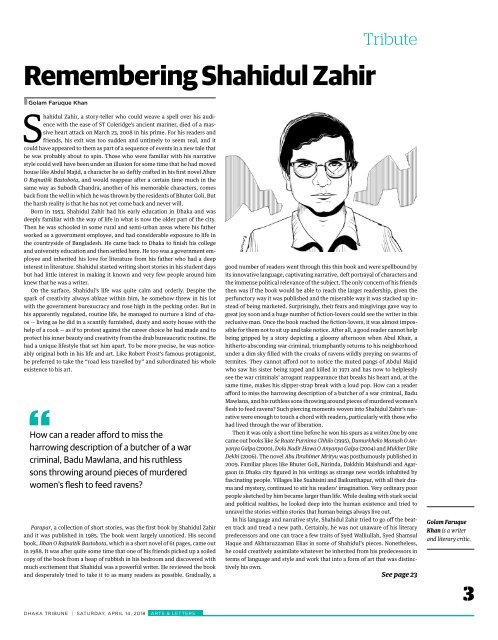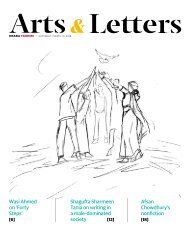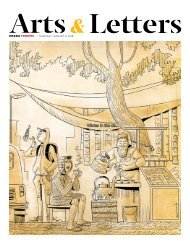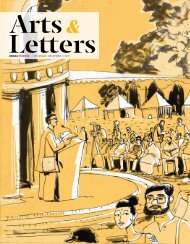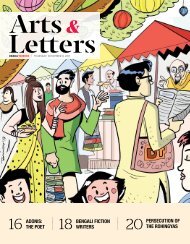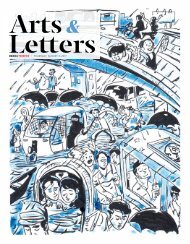Arts & Letters, April 2018
Create successful ePaper yourself
Turn your PDF publications into a flip-book with our unique Google optimized e-Paper software.
Remembering Shahidul Zahir<br />
Tribute<br />
• Golam Faruque Khan<br />
Shahidul Zahir, a story-teller who could weave a spell over his audience<br />
with the ease of ST Coleridge’s ancient mariner, died of a massive<br />
heart attack on March 23, 2008 in his prime. For his readers and<br />
friends, his exit was too sudden and untimely to seem real, and it<br />
could have appeared to them as part of a sequence of events in a new tale that<br />
he was probably about to spin. Those who were familiar with his narrative<br />
style could well have been under an illusion for some time that he had moved<br />
house like Abdul Majid, a character he so deftly crafted in his first novel Jiban<br />
O Rajnaitik Bastobota, and would reappear after a certain time much in the<br />
same way as Subodh Chandra, another of his memorable characters, comes<br />
back from the well in which he was thrown by the residents of Bhuter Goli. But<br />
the harsh reality is that he has not yet come back and never will.<br />
Born in 1953, Shahidul Zahir had his early education in Dhaka and was<br />
deeply familiar with the way of life in what is now the older part of the city.<br />
Then he was schooled in some rural and semi-urban areas where his father<br />
worked as a government employee, and had considerable exposure to life in<br />
the countryside of Bangladesh. He came back to Dhaka to finish his college<br />
and university education and then settled here. He too was a government employee<br />
and inherited his love for literature from his father who had a deep<br />
interest in literature. Shahidul started writing short stories in his student days<br />
but had little interest in making it known and very few people around him<br />
knew that he was a writer.<br />
On the surface, Shahidul’s life was quite calm and orderly. Despite the<br />
spark of creativity always ablaze within him, he somehow threw in his lot<br />
with the government bureaucracy and rose high in the pecking order. But in<br />
his apparently regulated, routine life, he managed to nurture a kind of chaos<br />
-- living as he did in a scantily furnished, dusty and sooty house with the<br />
help of a cook -- as if to protest against the career choice he had made and to<br />
protect his inner beauty and creativity from the drab bureaucratic routine. He<br />
had a unique lifestyle that set him apart. To be more precise, he was noticeably<br />
original both in his life and art. Like Robert Frost’s famous protagonist,<br />
he preferred to take the “road less travelled by” and subordinated his whole<br />
existence to his art.<br />
How can a reader afford to miss the<br />
harrowing description of a butcher of a war<br />
criminal, Badu Mawlana, and his ruthless<br />
sons throwing around pieces of murdered<br />
women’s flesh to feed ravens?<br />
Parapar, a collection of short stories, was the first book by Shahidul Zahir<br />
and it was published in 1985. The book went largely unnoticed. His second<br />
book, Jiban O Rajnaitik Bastobota, which is a short novel of 61 pages, came out<br />
in 1988. It was after quite some time that one of his friends picked up a soiled<br />
copy of the book from a heap of rubbish in his bedroom and discovered with<br />
much excitement that Shahidul was a powerful writer. He reviewed the book<br />
and desperately tried to take it to as many readers as possible. Gradually, a<br />
DHAKA TRIBUNE | SATURDAY, APRIL 14, <strong>2018</strong> ARTS & LETTERS<br />
good number of readers went through this thin book and were spellbound by<br />
its innovative language, captivating narrative, deft portrayal of characters and<br />
the immense political relevance of the subject. The only concern of his friends<br />
then was if the book would be able to reach the larger readership, given the<br />
perfunctory way it was published and the miserable way it was stacked up instead<br />
of being marketed. Surprisingly, their fears and misgivings gave way to<br />
great joy soon and a huge number of fiction-lovers could see the writer in this<br />
reclusive man. Once the book reached the fiction-lovers, it was almost impossible<br />
for them not to sit up and take notice. After all, a good reader cannot help<br />
being gripped by a story depicting a gloomy afternoon when Abul Khair, a<br />
hitherto-absconding war criminal, triumphantly returns to his neighborhood<br />
under a dim sky filled with the croaks of ravens wildly preying on swarms of<br />
termites. They cannot afford not to notice the muted pangs of Abdul Majid<br />
who saw his sister being raped and killed in 1971 and has now to helplessly<br />
see the war criminals’ arrogant reappearance that breaks his heart and, at the<br />
same time, makes his slipper-strap break with a loud pop. How can a reader<br />
afford to miss the harrowing description of a butcher of a war criminal, Badu<br />
Mawlana, and his ruthless sons throwing around pieces of murdered women’s<br />
flesh to feed ravens? Such piercing moments woven into Shahidul Zahir’s narrative<br />
were enough to touch a chord with readers, particularly with those who<br />
had lived through the war of liberation.<br />
Then it was only a short time before he won his spurs as a writer.One by one<br />
came out books like Se Raate Purnima Chhilo (1995), Dumurkheko Manush O Anyanya<br />
Galpa (2000), Dolu Nadir Hawa O Anyanya Galpa (2004) and Mukher Dike<br />
Dekhi (2006). The novel Abu Ibrahimer Mrityu was posthumously published in<br />
2009. Familiar places like Bhuter Goli, Narinda, Dakkhin Maishundi and Agargaon<br />
in Dhaka city figured in his writings as strange new worlds inhabited by<br />
fascinating people. Villages like Suahisini and Baikunthapur, with all their drama<br />
and mystery, continued to stir his readers’ imagination. Very ordinary poor<br />
people sketched by him became larger than life. While dealing with stark social<br />
and political realities, he looked deep into the human existence and tried to<br />
unravel the stories within stories that human beings always live out.<br />
In his language and narrative style, Shahidul Zahir tried to go off the beaten<br />
track and tread a new path. Certainly, he was not unaware of his literary<br />
predecessors and one can trace a few traits of Syed Walliullah, Syed Shamsul<br />
Haque and Akhtaruzzaman Elias in some of Shahidul’s pieces. Nonetheless,<br />
he could creatively assimilate whatever he inherited from his predecessors in<br />
terms of language and style and work that into a form of art that was distinctively<br />
his own.<br />
See page 23<br />
Golam Faruque<br />
Khan is a writer<br />
and literary critic.<br />
3


